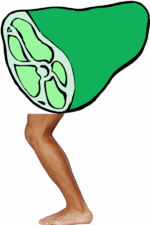UnBooks:A Logical Interpretation of “Green Eggs and Ham"
Hi, I present to you fine people my award winning analysis of Dr. Seuss' most famous work known simply as "Green Eggs and Ham." I have grown tired of people interpreting this book wrong, so now I must present the proper meaning to everyone via the web in the full hope to destroy insolence.
Opening[edit]
I’m going to write a paper about how Dr. Seuss’ children’s book “Green Eggs and Ham” is a reference to white Americans unwillingness to accept blacks. I first noticed this after reading the book several times in an attempt to get a Guinness World Record™ for "longest time reading “Green Eggs and Ham” by Dr. Seuss continuously without going to sleep" – after browsing their other records I didn’t find the acceptance of my record to be entirely unbelievable. Anyway, the ham represents black people due to its connections with Africa, the eggs represent Asians, and the guy who doesn’t want any of the green eggs and ham represents white American society, and the fact that he loves the foods after he eats them illustrates that there are many advantages to getting along with blacks and Asians, so people should accept them.
The Meaning of the Book[edit]
Not far into the book we are able to notice that the main character, not Sam-I-Am but the other guy, claims that he does not like green eggs and ham, but he also says that he has never actually tried them. This shows the close-mindedness of white society and its inability to accept other, competing cultures. Now, I’m not one to say that black are better than white, because, quite frankly, they aren’t, but at the same time I think we should accept all people, even retards and blacks. Asians on the other hand, as represented by eggs, should never be pushed aside due to their high level of naturally born intelligence. I believe Dr. Seuss felt the same way and that’s why he made Asians to be represented by eggs as opposed to ham, used to represent blacks. You see, ham is a fitting representation for blacks because it is a strong, earthy food and eggs represent Asians because they are delicate and classy.
The Black Man and Ham[edit]
We know that colored folk are represented by ham because of ham’s ties with African culture. In French ham is known as jambon[1], and in food a French ham is known as delicious. This connection between French and ham brings us to our next connection, which will eventually bring us face first into our connection between the ham and negroes, but at this point you’re probably asking, “Why couldn’t he be talking about the French?” If you knew any history on Dr. Seuss you would know that he was from an American-German family and therefore, naturally, he hated the French, so he wouldn’t write a book that ended in the acceptance and love of the French by white, American society. You see, the French had a strong colonial presence in Africa during the 1800s, and Dr. Seuss likely knew this, so he decided that would be a good way to incorporate a reference to black people without being too blatant. We can make this assumption on the fact that Dr. Seuss went to Lincoln* College and enrolled in the humanities department[2], and history is a branch of the humanities.
- Dr. Seuss actually went to Dartmouth College.
Connections Between Green and Black[edit]
We can further see the connection between this “green” ham and Africa through more modern problems in Asia. Because the color green is largely associated with sickness and the ham is green we can conclude that Seuss was saying the ham represented sick people. For nearly forever sickness has been plaguing Africa and what place contains more black people than Africa? The connection is quite obvious once we take this into account.
Asians and Eggs[edit]
The connection with Asians and eggs is just as unconventional and genius as Seuss’ connection between blacks and ham. The eggs are colored green and, along with sickness, green is often used to illustrate disgust. In a certain inferior part of Asia, a land that contains many Asians, there is a food composed of a boiled duckling egg with the embryo still intact called balut[3]. This food sounds disgusting, and due to the inferior Asians who eat it we can guess it is disgusting, so the connection is, again, quite obvious. Not only has Dr. Seuss included the greenness and egginess of the green eggs into a single way to reference the Asian people, but he has done it without making it to obvious to children, who most likely won’t know too much about the world. ==Conclusion==The reason Dr. Seuss wanted to keep the true meaning of his story hidden from children is because he didn’t want them to question their naturally born white powers over certain cultures, but he did want them to be able to look back when they were adults and go, “Hey, I think Dr. Seuss thinks we should accept a few different people (not the French), so let’s do that.” This is why he decided to use such vague references, but now that you have been illuminated into the deeper working of “Green Eggs and Ham” you too can say, “Hey, I think Dr. Seuss thinks we should accept a few different people (not the French), so let’s do that,” and do it.
Footnotes[edit]
^ 1. Just check any French dictionary or translation site and you will see that I’m correct.
^ 2. I found this here: http://en.wikipedia.org/wiki/Dr._Seuss
^ 3. Information on balut can be found here: http://www.tagalog-dictionary.com/pateros/balut.htm
